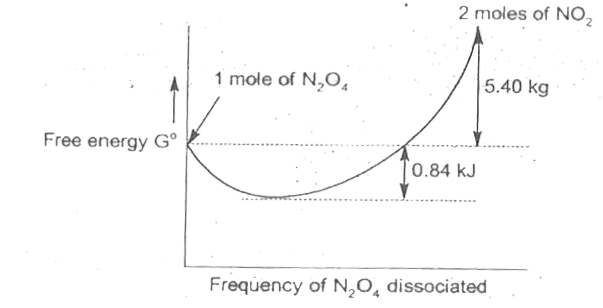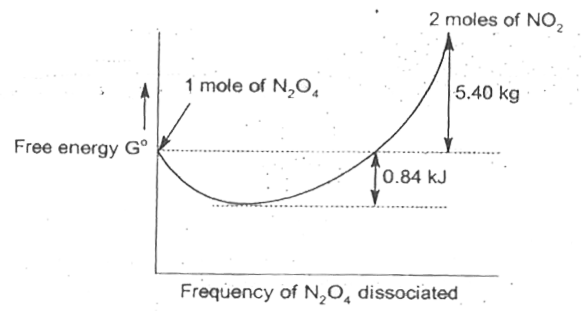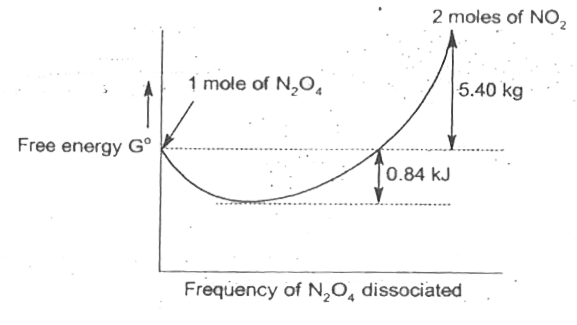The free energy change, ΔG = 0, when
The reactants are completely consumed
A catalyst is added
The system is at equilibrium
The reactants are initially start reacting
The correct Answer is:C
To solve the question regarding when the free energy change (ΔG) equals zero, we can analyze the options provided and apply our understanding of thermodynamics.
1. Understanding ΔG: The Gibbs free energy change (ΔG) is a thermodynamic quantity that indicates the spontaneity of a process. It can take three forms:
- ΔG < 0: The process is spontaneous.
- ΔG = 0: The system is at equilibrium.
- ΔG > 0: The process is non-spontaneous.
2. Analyzing the Options:
- Option 1: "The reactants are completely consumed."
- When reactants are completely consumed, the reaction has gone to completion. At this point, the system is not at equilibrium, and ΔG would be greater than zero as the process is no longer spontaneous. (Incorrect)
- Option 2: "A catalyst is added."
- A catalyst speeds up the reaction but does not change the Gibbs free energy of the system. It does not affect whether the process is spontaneous or at equilibrium. Therefore, ΔG remains unchanged and is not necessarily zero. (Incorrect)
- Option 3: "The system is at equilibrium."
- At equilibrium, the forward and reverse reactions occur at the same rate, and there is no net change in the concentrations of reactants and products. Here, ΔG is equal to zero. (Correct)
- Option 4: "The reactants are initially starting to react."
- When reactants begin to react, the process may be spontaneous, but it does not imply that ΔG is zero. In fact, during the initial stages, ΔG is typically less than zero as the reaction proceeds. (Incorrect)
3. Conclusion: The correct answer is that ΔG = 0 when the system is at equilibrium.
Final Answer:
The free energy change, ΔG = 0, when the system is at equilibrium.
---
- ΔG < 0: The process is spontaneous.
- ΔG = 0: The system is at equilibrium.
- ΔG > 0: The process is non-spontaneous.
- Option 1: "The reactants are completely consumed."
- When reactants are completely consumed, the reaction has gone to completion. At this point, the system is not at equilibrium, and ΔG would be greater than zero as the process is no longer spontaneous. (Incorrect)
- Option 2: "A catalyst is added."
- A catalyst speeds up the reaction but does not change the Gibbs free energy of the system. It does not affect whether the process is spontaneous or at equilibrium. Therefore, ΔG remains unchanged and is not necessarily zero. (Incorrect)
- Option 3: "The system is at equilibrium."
- At equilibrium, the forward and reverse reactions occur at the same rate, and there is no net change in the concentrations of reactants and products. Here, ΔG is equal to zero. (Correct)
- Option 4: "The reactants are initially starting to react."
- When reactants begin to react, the process may be spontaneous, but it does not imply that ΔG is zero. In fact, during the initial stages, ΔG is typically less than zero as the reaction proceeds. (Incorrect)
The free energy change, ΔG = 0, when the system is at equilibrium.
Topper's Solved these Questions
- THERMODYNAMICSBOOK - AAKASH INSTITUTE ENGLISHCHAPTER - THERMODYNAMICSEXERCISE - SECTION-B
20 Videos
- THERMODYNAMICSBOOK - AAKASH INSTITUTE ENGLISHCHAPTER - THERMODYNAMICSEXERCISE - SECTION-C
13 Videos
- THERMODYNAMICSBOOK - AAKASH INSTITUTE ENGLISHCHAPTER - THERMODYNAMICSEXERCISE - TRY YOURSELF
66 Videos
- THE SOLID STATE BOOK - AAKASH INSTITUTE ENGLISHCHAPTER - THE SOLID STATE EXERCISE - Assignment (SECTION - D) (ASSERTION-REASON TYPE QUESTION)
20 Videos
Similar Questions
The free energy change ΔG=0, when
View SolutionWhat is the free energy change, 'ΔG' When 1.0 mole of water at 100∘C and 1 atm pressure is converted into steam at 100∘C and 1 atm pressure
View SolutionThe relationship between the free energy change (ΔG) and entropy change (ΔS) at constant temperature (T) si
View SolutionFor the reaction, NH4Cl(s)→NH3(g)+HCl(g) at 25∘C, enthalpy change ΔH=+177kJmol−1 and entropy change ΔS=+285Jmol−1K−1. Calculate the free energy change ΔG at 25∘C and predict whether the reaction is spontaneous or not.
View SolutionA reaction is spontaneous if free energy change ΔG , for the reaction is negative .
The question arises, how we can explain , the spontaneous reversible reaction taking the example of dissociation equilibrium ,N2O4⇔2NO2(g).
the variation of free energy with the fraction of N2O4 dissociated under standard conditions is shown in the figure below.

The standard free energy change for the conversion of 1 mole of N2O4 into 2 moles of NO2 is
View SolutionA reaction is spontaneous if free energy change ΔG , for the reaction is negative . The question arises, how we can explain , the spontaneous of reversible reaction taking the example of dissociation equilibrium N2O4⇔2NO2(g) the variation of free energy with the fraction of N2O4 dissociated under standard conditions is shown in the figure below.

When 2 moles of NO2 change into equilibrium mixture the value of ΔG∘ is
View SolutionA reaction is spontaneous if free energy change ΔG for the reaction is negative . The question arises, how we can explain , the spontaneous reversible reaction. Taking the example of dissociation equilibrium N2O4⇔2NO2(g) the variation of free energy with the fraction of N2O4 dissociated under standard conditions is shown in the figure below.

When 1 mole of N2O4 changes into the equilibrium mixture the value of ΔG∘ is
View SolutionWhat is the free energy change (ΔG) for galvanic and electrolytic cel ?
View SolutionFor a chemical reaction, the free energy change (ΔG) is negative. The reaction is
View SolutionThe equlibrium constant kp for the reactin.2NOCL(g)⇔2NO(g)+Cl2(g) is 6.95⋅10−8 at 298K . The standard gibb free energy change ,ΔG0 at 298 K will be (R=2calK−1mol−1 ) (log 6.95 = 0 8420)
View Solution
